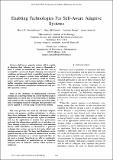Enabling technologies for self-aware adaptive systems
Author(s)
Santambrogio, Marco Domenico; Hoffmann, Henry Christian; Eastep, Jonathan Michael; Agarwal, Anant
DownloadAgarwal_Enabling technologies.pdf (168.9Kb)
PUBLISHER_POLICY
Publisher Policy
Article is made available in accordance with the publisher's policy and may be subject to US copyright law. Please refer to the publisher's site for terms of use.
Terms of use
Metadata
Show full item recordAbstract
Self-aware computer systems will be capable of adapting their behavior and resources thousands of times a second to automatically find the best way to accomplish a given goal despite changing environmental conditions and demands. Such a capability benefits a broad spectrum of computer systems from embedded systems to supercomputers and is particularly useful for meeting power, performance, and resource-metering challenges in mobile computing, cloud computing, multicore computing, adaptive and dynamic compilation environments, and parallel operating systems. Some of the challenges in implementing self-aware systems are a) knowing within the system what the goals of applications are and if they are meeting them, b) deciding what actions to take to help applications meet their goals, and c) developing standard techniques that generalize and can be applied to a broad range of self-aware systems. This work presents our vision for self-aware adaptive systems and proposes enabling technologies to address these three challenges. We describe a framework called Application Heartbeats that provides a general, standardized way for applications to monitor their performance and make that information available to external observers. Then, through a study of a self-optimizing synchronization library called Smartlocks, we demonstrate a powerful technique that systems can use to determine which optimization actions to take. We show that Heartbeats can be applied naturally in the context of reinforcement learning optimization strategies as a reward signal and that, using such a strategy, Smartlocks are able to significantly improve performance of applications on an important emerging class of multicore systems called asymmetric multicores.
Date issued
2010-06Department
Massachusetts Institute of Technology. Computer Science and Artificial Intelligence Laboratory; Massachusetts Institute of Technology. Department of Electrical Engineering and Computer ScienceJournal
NASA/ESA Conference on Adaptive Hardware and Systems.
Publisher
Institute of Electrical and Electronics Engineers
Citation
Santambrogio, M.D. et al. “Enabling Technologies for Self-aware Adaptive Systems.” Adaptive Hardware and Systems (AHS), 2010 NASA/ESA Conference On. 2010. 149-156. Copyright © 2010, IEEE
Version: Final published version
Other identifiers
INSPEC Accession Number: 11475100
ISBN
978-1-4244-5888-2
978-1-4244-5887-5